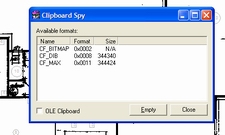|
|
This topic comprises 2 pages: 1 2
|
|
Author
|
Topic: Cluttered Desktop slows down Windows?
|
|
|
Brian Michael Weidemann
Expert cat molester

Posts: 944
From: Costa Mesa, CA United States
Registered: Feb 2004
|
 posted 08-30-2004 08:36 PM
posted 08-30-2004 08:36 PM





I think that anything on a desktop is treated differently. The system thinks that if it's on the desktop, it's going to be used (and probably really soon!), so everything is pre-loaded in memory, and ready at the drop of a hat. This is pretty much just speculation. It would make sense.
However, if nothing on the desktop itself loads particularly faster than from any other location, then this theory is shot. At which point I, too, am baffled at Windows' stupidity ... at least, moreso. ![[Confused]](confused.gif)
Another idea: saving a file wouldn't necessarily release the Print Screen capture from buffer memory (clipboard?), so that could be eating up stuff.
| IP: Logged
|
|
|
|
|
|
|
|
|
|
|
|
|
|
|
|
|
|
|
|
|
|
Bobby Henderson
"Ask me about Trajan."

Posts: 10973
From: Lawton, OK, USA
Registered: Apr 2001
|
 posted 08-31-2004 02:36 PM
posted 08-31-2004 02:36 PM




Joe, 256MB of RAM is just not enough memory for any WinXP Professional machine doing anything more than simple word processing tasks. I'll bet if you at least double the amount of RAM in that machine you'll see a significant improvement.
Our shop purchased one of those lower cost Dell systems for the front office with WinXP Pro loaded and 256MB of RAM. We had to add another 512MB DDR SDRAM DIMM to it to get good performance.
Regarding SATA, at first I thought it seemed to be a good advance for computers. The prospect of having affordable RAID, a smaller connector and faster data transfer seemed great. But then I started reading up about SATA and asking around. The custom PC builder friend of mine gave me an earful about toasted SATA 1 drives and how he was trying to buy up as many Ultra ATA 133 drives (7200rpm, 8MB cache) as he could find.
Here's an article I found online at this link:
http://www.ata-atapi.com/sata.htm
quote:
FIRST, THINGS YOU DO NOT DO WHEN USING SATA!
If you are setting up a system using SATA here are some things you must be aware of:
* DO NOT operate SATA devices outside of a sealed system unit. DO NOT operate SATA devices from a power supply that is not the system unit's power supply.
* DO NOT tie wrap SATA cables together. DO NOT put sharp bends in SATA cables. DO NOT route SATA cables near PATA cables. Avoid placing SATA devices close to each other such that the SATA cable connectors are close to each other.
* DO NOT operate a radio transmitter (such as a cell phone) near an exposed SATA cable or device.
Why all these warning? The basic problem is the SATA cable connector is not shielded. This has to be the number one most stupid thing that has been done in the SATA world.
SECOND, LETS TALK ABOUT SATA RELIABILITY!
Are you thinking about buying a Serial ATA system and drive? If yes, read this... The Serial ATA (or SATA) products that are now shipping and available in your local computer store may not be the most reliable products. Testing of SATA products with tools such ATACT program are finding a variety of problems. These problems are timeout errors, data compare errors, and strange status errors. These problems are being reported by a large number of people doing SATA product testing. Hale's advice at this time is be very careful - make sure you can return the SATA product your purchased if it does not perform as you expect. See the ATACT link above for some ATACT log files showing both normal testing of a parallel ATA (PATA) drive (no errors!) and testing of a SATA drive (lots of errors!).
The unshielded SATA cable connector is mostly like the source of many of these problems. Making things worse is the failure of the SATA specification to implement an equivalent to the ATA Soft Reset. On a PATA interface Soft Reset rarely fails to get ATA/ATAPI devices back to a known state so that a command can be retried. On a SATA interface the equivalent to this reset does not seem to reset anything and at some times it is basically ignored by the SATA controller and device.
And finally... Don't buy SATA because it claims to be faster than PATA. The marketing claims that it can transfer data at up to 150MB/second (making it faster than the fastest PATA Ultra DMA mode, mode 6 or 133MB/second) will not be seen with the SATA products that are shipping today (late 2003). Today's SATA products are actually 10% to 20% slower than PATA. This is because today's SATA products are really PATA products with an extra SATA-to-PATA 'bridge chip' in the device. These bridge chips add significant overhead to the SATA protocols. In time there will real 'native' SATA devices that do not need these bridge chips - Then we can see what the true performance of SATA. But remember SATA is a 'serial interface' and serial interfaces rarely live up to their marketing claims.
THIRD, BACK TO THE SATA BASICS...
THE SPECIFICATION MESS
Serial ATA or SATA may be the best thing to happen in the I/O interface world in a long time. But the way SATA has been developed has resulted in a huge confusing mess. We may be entering a period when not one but three or four separate organizations may be publishing SATA specifications and standards. Those organizations are: the SATA "secret society", the ANSI standards committee T13 (ATA/ATAPI), the ANSI standards committee T10 (SCSI) and a sub-group of T10 known as the Serial Attached SCSI (SAS) committee. Each of these organizations may publish versions of SATA that are slightly different.
How did we get to this state of affairs? First, several years ago Intel formed a "secret society" to work on a serial interface version of the traditional parallel ATA interface. That group of companies developed and published the SATA (now called SATA-1) specification. SATA devices that are shipping today (mid-year 2003) generally conform to this specification. Second, the SATA-1 specification has been given to the ANSI T13 committee and it has now become volume 3 of the ATA/ATAPI-7 standard. Third, the SATA secret society continues to work and now the SATA specification they have doesn't always match what is in ATA/ATAPI-7. And as you will see in the next section SATA and SAS may merge.
WHAT IS SATA?
SATA uses a 7 wire interface. Three of the wires are ground signals. The other 4 are two pairs of differential signals - one pair in each direction. SATA is using the transceiver technology used by Fiber (Fibre) Channel. Today's hardware runs at 1.5GHz and should be at 3GHz soon. ATA commands, status and data are transmitted in packets on this interface. This is done such that the traditional ATA command protocols are basically unchanged (more about this below).
How fast is SATA? Well... There are claims that it can transfer data up to 150Mbytes/second. Remember this is a burst data rate, not an average data rate. Parallel ATA using UltraDMA mode 6 (UltraDMA 133) claims it can transfer data up to 133Mbytes/second. Again this is a burst data rate and not an average data rate. Average data rates are probably less than 1/2 of these numbers, perhaps even as low as 1/3. Yes, SATA is in theory "faster" - but not by much.
SATA-1+ and SATA-2 (neither are part of ATA/ATAPI-7 at this time) include new data transfer and tagged command queuing schemes. It is unclear if these things will ever appear in future ATA/ATAPI-x standards. They may only appear in the SATA-2/SAS documents.
SATA supports a single device per SATA cable. A SATA cable can be longer than a parallel ATA cable (limited to 1.5 feet), perhaps up to 2 or 3 feet long.
SATA Programming (Today)
2003...
SATA-1, the SATA version that will be included in ATA/ATAPI-7, is designed to emulate traditiional parallel ATA. Most SATA host controllers shipping today look like and are programmed just like any other ATA host controller. These controllers are compatible with the Intel ICHx design and compatible with the T13 1510D document. This allows SATA controllers and devices to be used in systems without BIOS or OS driver changes.
The biggest problem with today's SATA host controllers is that SATA gets errors that never happened on PATA. And today's SATA host controllers do a very poor job of reporting these errors to the host software. Then there is the problem of having an OS device driver for SATA that understands these errors and knows how to recover from the error conditions. As of September 2003 T13 is just now starting to talk about these problems.
There are some SATA host controllers that are not ICHx compatible and these require proprietary BIOS or OS drivers. We can only hope that the Intel AHCI specification effort is successful in bringing us a new and better SATA host controller standard.
SATA Programming (Tomorrow)
2004 and beyond...
We don't know what SATA host controllers will look like a year from now. We can only hope that we will finally have controllers that will support four to eight or more SATA devices and that all devices will be able to transfer data at the same time. Basically this finally gives us the kind of I/O we want (and/or need), fully independent I/O for each mass storage device, no more waiting for one device to finish a command before we can start a command on another device.
The problem today is that there is no public standard for how future SATA controllers should be designed or programmed. Intel has announced that they something called the AHCI specification. But today (late 2003) this specification is under NDA.
Serial ATA-2 (SATA-2)
or is it
Serial Attached SCSI (SAS)?
Soon after completing the SATA-1 specification the SATA "secret society" continue working and have joined forces with the Serial Attached SCSI (SAS) sub-committee of T10 to merge SATA and SAS. The result so far is yet another version of SATA known as SATA-2. The end result is unclear. There are lots of poeple that would like to replace SCSI - remember 1394 was going to replace SCSI. It is fun to read some of the marketing hype: SATA and SAS have joined forces to "create the I/O interface that will solve every problem every known to exist in I/O interfaces". When have we heard this before?
| IP: Logged
|
|
|
|
|
|
|
|
All times are Central (GMT -6:00)
|
This topic comprises 2 pages: 1 2
|
Powered by Infopop Corporation
UBB.classicTM
6.3.1.2
The Film-Tech Forums are designed for various members related to the cinema industry to express their opinions, viewpoints and testimonials on various products, services and events based upon speculation, personal knowledge and factual information through use, therefore all views represented here allow no liability upon the publishers of this web site and the owners of said views assume no liability for any ill will resulting from these postings. The posts made here are for educational as well as entertainment purposes and as such anyone viewing this portion of the website must accept these views as statements of the author of that opinion
and agrees to release the authors from any and all liability.
|

 Home
Home
 Products
Products
 Store
Store
 Forum
Forum
 Warehouse
Warehouse
 Contact Us
Contact Us




 Printer-friendly view of this topic
Printer-friendly view of this topic







![[Confused]](confused.gif)







![[Razz]](tongue.gif)




